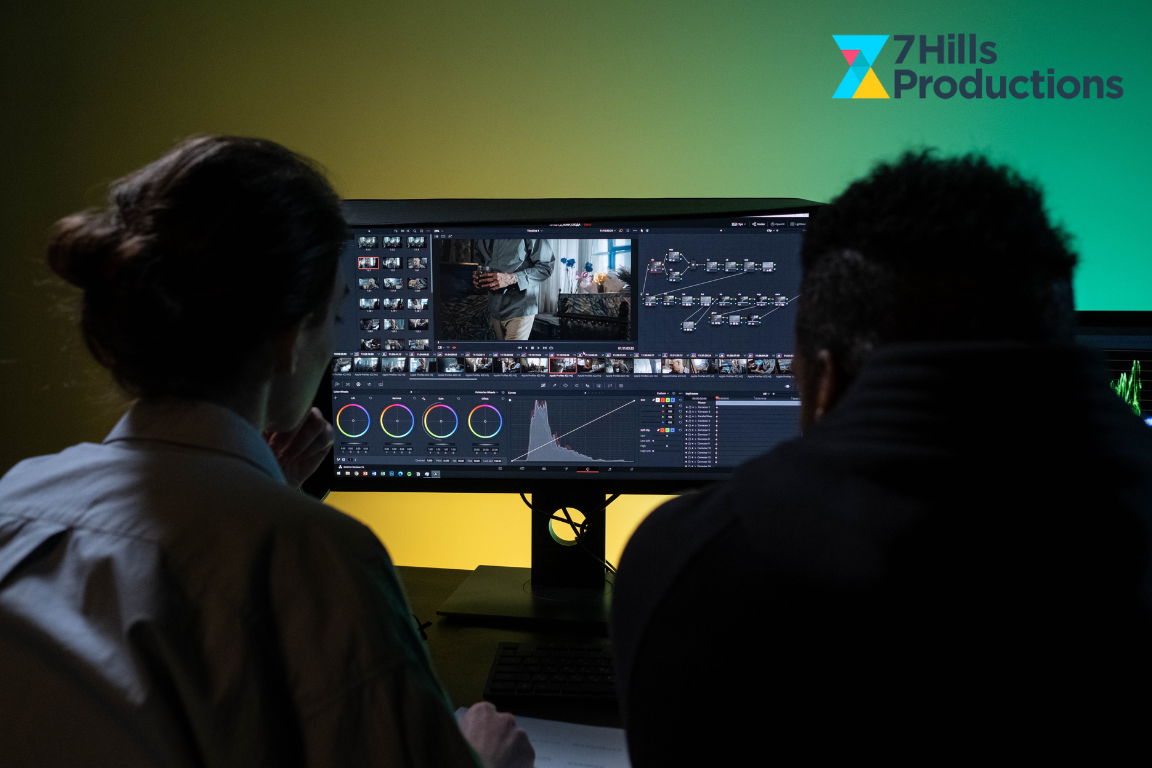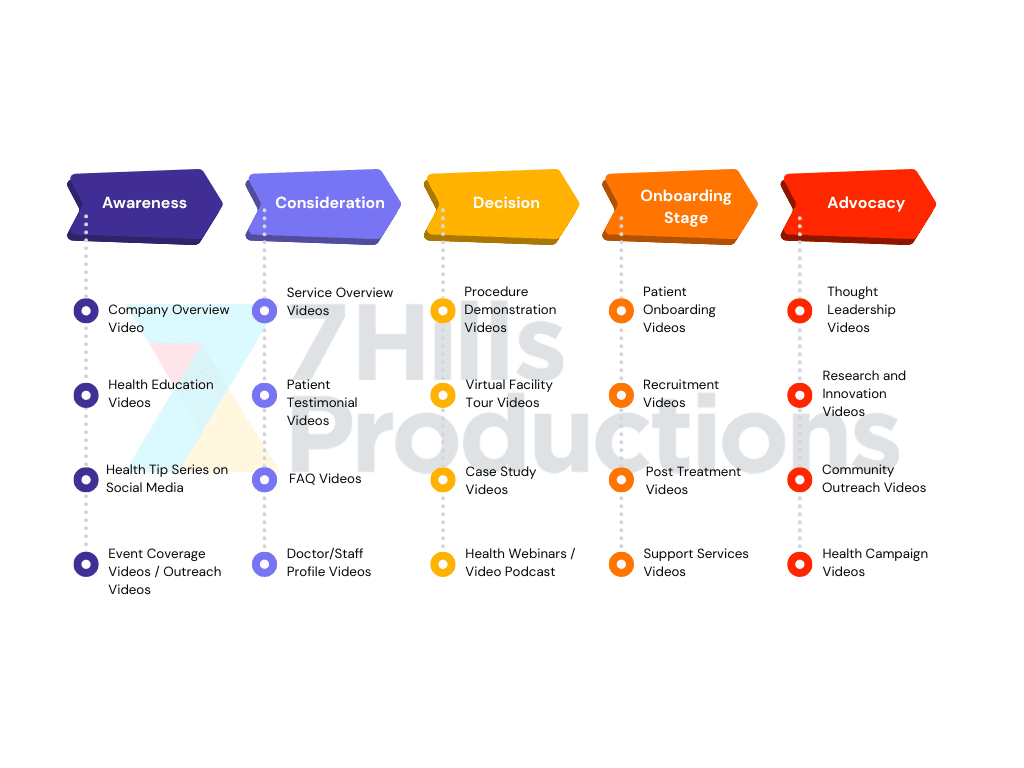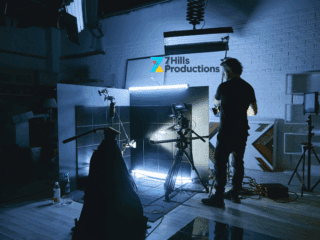Complete Guide for Healthcare Video Production
Healthcare video production can significantly enhance patient education and medical communication. This guide covers essential steps from goal-setting to distribution, ensuring your videos meet industry standards and ethical requirements. You’ll learn how to plan, film, and edit medical content effectively, while addressing compliance issues unique to healthcare. By following this guide, you’ll create impactful videos that inform patients, showcase medical innovations, and promote your healthcare services effectively.
Define Goals for Your Healthcare Video Content

Defining clear goals for healthcare video content is crucial for effective production. This process involves identifying the target audience, aligning objectives with marketing or educational aims, setting key performance indicators, and establishing budget parameters. By focusing on these elements, healthcare organizations can create impactful videos that comply with regulatory requirements, optimize search engine performance, and effectively convey information about medications or treatments.
Identify Your Target Audience Within Healthcare
Identifying the target audience within healthcare is essential for creating effective video content. Healthcare organizations must consider various segments, including patients, healthcare providers, and stakeholders. By understanding the specific needs and preferences of each group, content creators can tailor their messaging to improve adherence to medical advice, enhance brand recognition, and promote medical software solutions.
The target audience selection process should account for factors such as age, medical conditions, and technological proficiency. For example, videos addressing coronavirus prevention may target a broad audience, while content about specialized treatments or medical software might focus on healthcare professionals. This targeted approach ensures that the marketing efforts resonate with the intended viewers and achieve the desired outcomes:
Align Video Objectives With Marketing or Educational Aims
Aligning video objectives with marketing or educational aims is crucial for healthcare organizations to create impactful content. By understanding the specific goals, whether they involve increasing brand awareness, providing medical education, or showcasing patient testimonials, healthcare providers can tailor their video production strategies accordingly. This alignment ensures that the content resonates with the target audience and achieves the desired outcomes.
Effective alignment often involves collaboration between marketing teams and medical professionals to ensure accuracy and relevance. This process may include location scouting for authentic healthcare settings and considering whether outsourcing video production is necessary to achieve the desired quality. By carefully matching objectives with content, healthcare organizations can create videos that effectively communicate complex medical information while meeting their marketing or educational goals.
Set Key Performance Indicators for Healthcare Videos
Setting key performance indicators (KPIs) for healthcare videos is essential for measuring success and optimizing content strategies. Healthcare organizations can track metrics such as view count, engagement rate, and conversion rates to assess the effectiveness of their video content in communicating important health information, including updates on viruses or new treatments. These KPIs help healthcare providers gauge the impact of their videos on patient education and brand awareness within the healthcare industry.
Effective KPIs for healthcare videos may also include metrics specific to the content type, such as completion rates for animated explainer videos or click-through rates for calls-to-action in promotional content. By analyzing these indicators, healthcare marketers and animators can refine their approach to video production, ensuring that future content resonates with the target audience and achieves the desired outcomes in patient care and healthcare communication.
Establish Budget Parameters for Production
Establishing budget parameters for healthcare video production requires a careful balance between creativity and financial constraints. Organizations must consider the scope of their projects, including patient-focused content and therapy demonstrations, to allocate resources effectively. By setting clear budget guidelines, healthcare providers can ensure that their video content captures attention while remaining cost-effective.
The production budget should account for various elements within the healthcare landscape, such as specialized equipment, location fees, and talent costs. Healthcare organizations can prioritize their spending based on the video’s objectives, whether it’s to educate patients, showcase medical advancements, or promote specific treatments. A well-defined budget enables producers to make informed decisions throughout the production process, ensuring the final product meets both financial and creative goals:
- Assess project scope and objectives
- Determine required resources (equipment, talent, locations)
- Allocate funds for pre-production, production, and post-production phases
- Consider outsourcing options for specialized skills
- Set contingency funds for unexpected expenses
Plan Your Healthcare Video Production Approach
Planning healthcare video production involves developing compelling narratives, writing sensitive scripts, creating storyboards, scouting appropriate locations, and preparing talent. This approach ensures healthcare videos effectively convey information to patients while adhering to medical standards. Careful design and onboarding of relevant elements contribute to producing impactful content that resonates with the target audience and achieves educational or marketing objectives.
Develop Compelling Concepts for Healthcare Narratives
Developing compelling concepts for healthcare narratives involves creating engaging stories that resonate with the community while addressing medical topics. Healthcare video producers must balance the need for accurate medical information with storytelling techniques that capture viewers’ attention, ensuring a strong return on investment for healthcare organizations.
Effective healthcare narratives often incorporate explainer elements to break down complex medical concepts for a general audience. By combining real patient experiences with expert medical insights, video producers can craft narratives that educate and inspire, ultimately improving healthcare outcomes and fostering trust in the medical community.
Write Scripts Sensitive to Medical Topics
Writing scripts for healthcare videos requires sensitivity to medical topics and confidentiality concerns. Healthcare professionals must collaborate closely with video production teams to ensure accurate information is presented while maintaining patient privacy. Storyboards can help visualize sensitive content before production begins, allowing for necessary adjustments.
Healthcare marketing scripts should strike a balance between engaging storytelling and medical accuracy. Video producers must carefully craft language that is accessible to the target audience while respecting the complexity of healthcare topics. To ensure high-quality results, organizations may request a quote from specialized healthcare video production companies experienced in handling sensitive medical content.
Create Storyboards for Visual Planning
Creating storyboards for visual planning is a crucial step in healthcare video production. Storyboards help healthcare providers and video production teams visualize key scenes, including those featuring health software demonstrations or office settings in the United Kingdom. This process ensures that the final video effectively communicates complex medical information while maintaining an engaging visual flow.
Effective storyboarding incorporates elements such as music selection and visual cues to enhance the viewer’s understanding of health-related topics. By mapping out each scene, healthcare video producers can identify potential challenges and optimize the use of resources, resulting in a more polished final product. A well-crafted storyboard serves as a blueprint for the entire production process, ensuring that all team members are aligned on the video’s goals and visual direction:
Scout Appropriate Locations for Healthcare Settings
Scouting appropriate locations for healthcare settings is crucial for creating authentic and impactful video content. Video producers must consider factors such as privacy regulations, accessibility for medical equipment, and the ability to showcase vaccine administration or insurance processes. Selecting the right location enhances the marketing strategy by providing a realistic backdrop that resonates with the target audience and reinforces the credibility of the healthcare message.
When choosing filming locations, producers should prioritize settings that align with the video’s language and tone, whether it’s a clinical environment for medical research or a more relaxed atmosphere for patient testimonials. The selected location should accommodate the necessary equipment and personnel while allowing for flexibility in shooting angles and lighting setups. This careful consideration of the filming environment ensures that the final product effectively communicates the intended healthcare message and supports the overall marketing objectives.
Prepare Talent and Secure Necessary Permissions
Preparing talent for healthcare video production involves selecting individuals who can effectively communicate complex medical concepts while maintaining authenticity. Whether using medical professionals or actors, producers must ensure that the talent can convey the narrative accurately, particularly for explainer videos that may incorporate artificial intelligence or advanced graphics. Proper preparation includes thorough briefings on the video’s concept and objectives, as well as rehearsals to refine delivery and timing.
Securing necessary permissions is crucial in healthcare video production to comply with privacy regulations and ethical standards. This process includes obtaining written consent from all participants, including patients and healthcare providers, and ensuring that any proprietary information or medical technologies featured in the video are approved for public display. Producers must also consider licensing requirements for any graphics or artificial intelligence tools used in the production, particularly for explainer videos that rely heavily on visual aids to convey complex healthcare concepts.

Master the Filming Process for Medical Content
Mastering the filming process for medical content involves selecting appropriate equipment, applying effective lighting techniques, directing on-camera talent, capturing high-quality B-roll, and managing on-set logistics. This section covers essential aspects of healthcare video production, including considerations for live streaming surgeries, cost-effective tools for nurses, and techniques to ensure professional results in clinical environments.
Select Suitable Camera and Audio Equipment
Selecting suitable camera and audio equipment is crucial for producing high-quality healthcare videos that promote innovation and brand awareness. Healthcare organizations must invest in cameras capable of capturing clear, detailed footage in various clinical settings, while also considering audio systems that can record crisp sound even in challenging environments. This combination ensures that biotech videos and other medical content can effectively showcase advancements and procedures on websites and other digital platforms.
When choosing equipment for healthcare video production, producers must consider factors such as portability, low-light performance, and compatibility with existing systems. For instance, compact mirrorless cameras may be ideal for capturing footage in tight spaces, while professional-grade microphones can help isolate voices from background noise in busy hospital settings. By carefully selecting appropriate gear, healthcare organizations can create compelling content that adheres to legal requirements while effectively communicating complex medical information:
Apply Effective Lighting Techniques for Clinical Environments
Effective lighting techniques are crucial for creating high-quality healthcare videos, especially when showcasing medical devices or demonstrating clinical workflows. Producers must balance the need for clear visibility with the preservation of a natural, clinical atmosphere. By utilizing a combination of soft, diffused lighting and strategically placed key lights, video teams can enhance the visual appeal of brand videos while maintaining the authenticity of medical environments.
When creating explainer videos for medical procedures or devices, proper lighting helps convey the message clearly and professionally. Filmmakers should consider using adjustable LED panels to control color temperature and intensity, ensuring accurate representation of skin tones and medical equipment. This attention to lighting detail not only improves the overall quality of the video but also reinforces the brand’s commitment to precision and excellence in healthcare:
Direct on-Camera Talent Including Patients and Professionals
Directing on-camera talent in healthcare video production requires a delicate balance of professionalism and empathy, particularly when working with patients and medical professionals. Producers must guide participants to convey complex clinical information clearly while maintaining a natural, relatable demeanor. This approach enhances the educational value of the content, making it more accessible to viewers seeking information about brain health or nursing practices.
Effective direction involves careful editing of on-camera performances to ensure clarity and accuracy in presenting medical information. Producers should leverage educational technology to support talent in delivering their messages effectively, whether demonstrating nursing procedures or explaining complex brain functions. By focusing on clear communication and authentic representation, healthcare videos can serve as powerful tools for patient education and professional development in clinical settings.
Capture High-Quality B-Roll Footage
Capturing high-quality B-roll footage enhances the visual complexity and depth of healthcare videos, providing essential context and visual interest. Videographers must approach B-roll capture with a keen eye for detail, focusing on the organization of medical environments, the intricacies of medical equipment, and the nuanced interactions between healthcare professionals and patients. This footage serves as a valuable educational tool, illustrating complex medical concepts and procedures in a visually engaging manner.
To ensure the highest quality B-roll, videographers should utilize a variety of camera techniques, including selective focus and thoughtful composition. They must carefully crop shots to highlight key elements while maintaining patient privacy and adhering to healthcare regulations. By capturing a diverse range of B-roll footage, producers create a rich visual library that enhances the overall production value and supports the communication of complex medical knowledge to viewers.
Manage on-Set Logistics Smoothly
Managing on-set logistics smoothly is crucial for successful healthcare video production. Video production services must coordinate with medical facilities, ensuring minimal disruption to patient care while capturing authentic footage. This process involves careful scheduling, obtaining necessary permissions, and adhering to strict hygiene protocols, especially when filming in sensitive areas like operating rooms or intensive care units.
Effective on-set management requires clear communication between the video production corporate team and healthcare staff. Producers must demonstrate empathy and respect for the medical environment, adapting their storytelling approach to accommodate the unique challenges of healthcare settings. By prioritizing patient privacy and safety, video teams can create compelling content that accurately represents organizations like UnitedHealth Group while maintaining the integrity of medical practice:
- Coordinate with facility administrators for access and scheduling
- Brief crew on healthcare-specific protocols and privacy regulations
- Establish clear communication channels with medical staff
- Prepare contingency plans for unexpected medical emergencies
- Ensure proper sanitization of equipment between shots

Execute Post-Production for Polished Healthcare Videos
Post-production is crucial for creating polished healthcare videos that effectively communicate with customers and the public. This phase involves editing footage for clarity, incorporating motion graphics for medical explanations, selecting appropriate music, recording professional voiceovers, and implementing color correction. These steps ensure the final product meets the high standards required for healthcare communication, whether for learning purposes or public service announcements.
Edit Footage for Clarity and Narrative Flow
Editing footage for clarity and narrative flow is a critical step in healthcare video production, especially for biotechnology companies seeking to communicate complex research findings. A skilled video production company can transform raw footage into a coherent story, ensuring that the final product effectively conveys key messages about medical advancements or treatment options. This process involves carefully selecting and arranging clips to create a logical progression of information, enhancing accessibility for viewers while maintaining scientific accuracy.
To achieve optimal results, editors must consider factors such as pacing, visual continuity, and the integration of supporting graphics or animations. This attention to detail helps maintain viewer engagement throughout the video, particularly when explaining intricate biotechnology concepts. By focusing on clarity and narrative flow, healthcare video producers can create high-quality content that justifies its price point while effectively educating audiences about important medical research and innovations.
Incorporate Graphics and Animations for Medical Explanations
Incorporating graphics and animations in healthcare videos enhances patient safety education by visually explaining complex medical concepts. These visual aids, often created by specialized agencies like Demo Duck, effectively break down jargon-heavy information about diseases and treatments. By utilizing technology to create clear, engaging visuals, healthcare providers can ensure that patients better understand their conditions and treatment options.
Animations prove particularly useful when demonstrating the progression of a disease or the mechanism of action for new medications. These dynamic visuals can simplify intricate biological processes, making them accessible to a broader audience. By combining expert medical knowledge with skilled animation techniques, healthcare video producers can create compelling content that educates patients while maintaining their interest throughout the presentation.
Select Appropriate Music and Sound Design
Selecting appropriate music and sound design for healthcare videos is crucial for creating an engaging and professional experience. Video producers must consider the budget constraints while choosing music that complements the content without overshadowing important medical information. For training videos, such as those produced by Pfizer, the audio should enhance learning retention and maintain viewer attention throughout the presentation.
Sound design plays a vital role in reinforcing key data points and emphasizing critical information in healthcare videos. Producers can utilize subtle audio cues to highlight important statistics or treatment outcomes, enhancing the viewer’s understanding of complex medical concepts. When creating videos for pharmaceutical companies like Pfizer, sound designers must ensure that the audio elements align with the brand’s tone and regulatory requirements, creating a cohesive and compliant final product.
- Assess budget for music licensing and custom sound design
- Choose music that enhances the video’s message without distracting from medical content
- Incorporate audio cues to emphasize key data points and statistics
- Ensure sound design aligns with brand guidelines and regulatory requirements
- Optimize audio for various playback devices and environments
Record Professional Voiceovers When Needed
Professional voiceovers are essential for healthcare video production, particularly when conveying complex medical information. A skilled video production agency can collaborate with physicians to ensure accurate pronunciation of medical terms and clear delivery of critical information. This approach enhances the credibility and effectiveness of video marketing efforts in the healthcare sector.
Videography experts understand the importance of selecting the right voice talent to match the tone and message of healthcare content. Whether explaining new treatments or demonstrating medical procedures, a professional voiceover can significantly improve viewer engagement and retention. By investing in high-quality audio narration, healthcare organizations can create polished, informative videos that resonate with their target audience.
Implement Color Correction for Accurate Visuals
Color correction is a crucial step in healthcare video post-production, ensuring accurate representation of medical procedures, skin tones, and clinical environments. Video editors must carefully adjust color balance, contrast, and saturation to maintain visual consistency across different shots and lighting conditions. This process is particularly important for healthcare videos, where precise color representation can impact the viewer’s understanding of medical conditions or treatments.
Implementing color correction techniques enhances the overall quality and professionalism of healthcare videos. Editors use specialized software to fine-tune each frame, correcting any color discrepancies that may have occurred during filming. This attention to detail ensures that medical professionals and patients alike can rely on the visual information presented in the video, contributing to more effective communication of healthcare concepts and procedures:
- Adjust white balance for accurate skin tone representation
- Correct color casts from artificial lighting in clinical settings
- Enhance contrast to improve visibility of medical instruments
- Standardize color across multiple camera angles and shots
- Ensure consistent color representation across different viewing devices
Address Compliance and Ethical Standards in Healthcare Videos
Addressing compliance and ethical standards is crucial in healthcare video production. This section covers upholding HIPAA regulations, obtaining informed consent, securing institutional review board approvals, ensuring medical accuracy, and managing legal disclaimers. By adhering to these guidelines, healthcare organizations can create effective, legally compliant videos that respect patient privacy and maintain professional integrity.
Uphold HIPAA Regulations and Patient Confidentiality
Healthcare video producers must prioritize HIPAA compliance and patient confidentiality throughout the production process. This involves implementing strict protocols for handling sensitive patient information, obtaining proper consent forms, and ensuring that all team members are trained in HIPAA regulations. Video crews should work closely with healthcare providers to identify and protect any potentially identifiable patient data, including visual elements and spoken information.
To maintain patient privacy, healthcare video producers often employ techniques such as blurring faces, using actors instead of real patients, and carefully scripting dialogues to avoid revealing personal health information. These measures not only protect patient rights but also build trust with viewers, demonstrating the organization’s commitment to ethical practices in healthcare communication. By upholding HIPAA standards, healthcare videos can effectively convey important medical information while respecting individual privacy.
Obtain Informed Consent From All Participants
Obtaining informed consent from all participants is a critical ethical and legal requirement in healthcare video production. Video producers must develop comprehensive consent forms that clearly outline the purpose of the video, how it will be used, and the potential risks or benefits of participation. These forms should be written in plain language, easily understood by patients and healthcare professionals alike, to ensure genuine informed consent.
Healthcare video production teams must allow sufficient time for participants to review consent forms and ask questions before filming begins. It’s essential to emphasize that participation is voluntary and that individuals can withdraw their consent at any time. By prioritizing informed consent, healthcare organizations demonstrate their commitment to ethical practices and build trust with both participants and viewers, ultimately enhancing the credibility of their video content.
Secure Institutional Review Board Approvals if Applicable
Securing Institutional Review Board (IRB) approvals is a crucial step for healthcare video productions involving research subjects or clinical trials. Video producers must submit detailed protocols outlining the project’s objectives, participant selection criteria, and potential risks to the IRB for review. This process ensures that the video production adheres to ethical standards and protects the rights and welfare of human subjects involved in the project.
Healthcare organizations should allocate sufficient time for the IRB approval process, as it may require multiple rounds of revision and clarification. Once approved, video producers must strictly adhere to the approved protocol throughout the production process. By obtaining IRB approval, healthcare video producers demonstrate their commitment to ethical research practices and enhance the credibility of their content within the medical community.
Review Content for Medical Accuracy and Clarity
Reviewing content for medical accuracy and clarity is a critical step in healthcare video production. Healthcare organizations must involve medical experts to scrutinize scripts, visuals, and final edits, ensuring that all information presented is up-to-date, evidence-based, and aligned with current medical standards. This process helps maintain the credibility of the content and mitigates the risk of disseminating incorrect or misleading health information.
To enhance clarity, healthcare video producers should employ plain language techniques, avoiding jargon and complex medical terms when possible. When technical terms are necessary, they should be clearly defined or explained visually. This approach ensures that the content is accessible to a wide audience, including patients with varying levels of health literacy. The review process should also focus on the logical flow of information, ensuring that complex medical concepts are presented in a coherent and easily understandable manner:
- Consult with subject matter experts for content verification
- Use plain language to explain complex medical concepts
- Provide clear definitions for necessary technical terms
- Ensure logical flow of information throughout the video
- Incorporate visual aids to enhance understanding of medical concepts
Manage Disclaimers and Required Legal Text
Managing disclaimers and required legal text is a critical aspect of healthcare video production. Video producers must work closely with legal teams to ensure that all necessary disclosures are included in the final product, addressing potential risks, side effects, and limitations of medical treatments or procedures discussed. These disclaimers should be presented clearly and prominently, often at the beginning or end of the video, to comply with regulatory requirements and protect both the healthcare organization and viewers.
Healthcare video producers must strike a balance between providing comprehensive legal information and maintaining viewer engagement. They can employ creative techniques, such as using lower thirds or subtle animations, to integrate disclaimers seamlessly into the video content. By carefully managing legal text, healthcare organizations can create informative and compliant videos that effectively communicate important medical information while mitigating legal risks.

Distribute and Evaluate Your Healthcare and Biotech Videos
Effective distribution and evaluation are crucial for maximizing the impact of healthcare and biotech videos. This section explores strategies for choosing optimal platforms, optimizing for search engines and accessibility, promoting across channels, analyzing viewer engagement, and refining future video strategies. By implementing these approaches, healthcare organizations can ensure their video content reaches the intended audience and achieves its objectives.
Choose Optimal Platforms for Reaching Healthcare Audiences
Selecting the optimal platforms for distributing healthcare and biotech videos is crucial for reaching target audiences effectively. Healthcare organizations must consider factors such as audience demographics, content type, and platform-specific features when choosing where to share their videos. For instance, professional networking sites like LinkedIn may be ideal for reaching healthcare professionals, while patient-focused content might perform better on YouTube or Facebook.
To maximize reach and engagement, healthcare video producers should develop a multi-platform strategy tailored to their specific goals and target audience. This approach may include leveraging medical-specific platforms, such as WebMD or Medscape, alongside mainstream social media channels. By carefully selecting and optimizing content for each platform, healthcare organizations can ensure their videos reach the intended audience and achieve maximum impact:
- Analyze audience demographics and preferences
- Match content type to platform features
- Utilize medical-specific platforms for targeted reach
- Implement a multi-channel distribution strategy
- Optimize video format and length for each platform
Optimize Videos for Search Engines and Accessibility
Optimizing healthcare videos for search engines and accessibility is crucial for reaching a wider audience and ensuring inclusivity. Video producers should focus on creating descriptive titles, meta descriptions, and tags that incorporate relevant medical keywords to improve search engine rankings. Additionally, implementing closed captions and transcripts not only enhances accessibility for viewers with hearing impairments but also boosts SEO by providing text-based content for search engines to index.
To further improve accessibility and search engine optimization, healthcare video producers should consider the following best practices:
- Use clear, concise language in video titles and descriptions
- Include relevant medical terms and keywords naturally throughout the content
- Create custom thumbnails that accurately represent the video’s content
- Implement structured data markup to provide additional context for search engines
- Ensure videos are responsive and compatible with various devices and platforms
Promote Your Healthcare Videos Across Channels
Promoting healthcare videos across channels requires a strategic approach to maximize reach and engagement. Healthcare organizations should leverage a mix of organic and paid promotion strategies across various platforms, including social media, email marketing, and professional networks. By tailoring content for each channel and utilizing platform-specific features, organizations can effectively distribute their videos to target audiences.
To enhance the impact of healthcare video promotion, organizations should consider collaborating with industry influencers, participating in relevant online communities, and incorporating videos into their broader content marketing strategy. This multi-faceted approach ensures that valuable healthcare information reaches a wider audience, ultimately improving patient education and engagement. Key strategies for effective cross-channel promotion include:
- Develop platform-specific content adaptations
- Utilize paid advertising options on social media platforms
- Incorporate videos into email newsletters and campaigns
- Share videos in relevant professional forums and discussion groups
- Collaborate with healthcare influencers for extended reach
Analyze Viewer Engagement and Performance Metrics
Analyzing viewer engagement and performance metrics is crucial for healthcare organizations to assess the effectiveness of their video content. By tracking key indicators such as view count, watch time, and audience retention rates, healthcare marketers can gain valuable insights into how their videos resonate with target audiences. These metrics help identify which topics and formats are most engaging, enabling organizations to refine their video strategies and improve future content.
To effectively analyze performance, healthcare video producers should utilize analytics tools provided by distribution platforms and implement custom tracking mechanisms. This data-driven approach allows organizations to measure the impact of their videos on patient education, brand awareness, and conversion rates. By regularly reviewing these metrics, healthcare marketers can make informed decisions about content creation, distribution strategies, and resource allocation:
- Monitor view counts and unique viewers
- Analyze audience retention and drop-off points
- Track engagement metrics such as likes, comments, and shares
- Measure click-through rates for calls-to-action
- Assess the impact of videos on website traffic and conversions
Refine Future Biotech Video Strategies Based on Results
Refining future biotech video strategies based on results involves a systematic analysis of performance metrics and viewer feedback. Video producers should closely examine engagement rates, watch times, and conversion metrics to identify successful elements and areas for improvement. This data-driven approach enables biotech companies to tailor their content to audience preferences, ensuring future videos resonate more effectively with their target viewers.
Implementing A/B testing for different video formats, lengths, and styles can provide valuable insights for strategy refinement. By continuously iterating based on performance data, biotech companies can optimize their video content to better educate stakeholders, showcase innovations, and drive engagement within the scientific community. This iterative process helps ensure that future biotech videos align more closely with audience needs and organizational objectives.
Frequently Asked Questions
How do I define clear goals for my healthcare video content?
Defining clear goals for healthcare video content starts with identifying the target audience and desired outcomes. Consider the specific information or behavioral changes you want to convey, such as increasing awareness of a medical condition, promoting preventive care, or explaining a treatment process. Align your video goals with broader organizational objectives and key performance indicators. Determine measurable metrics like viewer engagement, knowledge retention, or patient action rates. Set realistic timelines and budgets, and establish a framework for evaluating the video’s effectiveness in achieving its intended purpose.
What are key considerations when planning a healthcare video production?
Healthcare video production requires careful planning to ensure compliance with medical regulations and patient privacy laws. Producers must prioritize accurate information, sensitive portrayal of medical conditions, and clear communication of complex healthcare concepts. Collaborating with medical professionals ensures content accuracy and credibility. The production team should consider the target audience, whether patients, healthcare providers, or the general public, and tailor the messaging accordingly. Lighting, sound quality, and visual aesthetics are crucial for creating engaging and professional healthcare videos. Incorporating patient testimonials or medical expert interviews can enhance the video’s impact and trustworthiness.
What techniques ensure high-quality filming of medical content?
High-quality medical content filming requires specialized techniques. Proper lighting ensures accurate color representation and clear visibility of procedures. Stable camera work, often using tripods or gimbals, minimizes shaking. High-resolution cameras capture fine details, while sterile equipment and protective gear maintain a safe environment. Audio quality is crucial for capturing important instructions or explanations. Directional microphones help isolate relevant sounds. Multiple camera angles provide comprehensive coverage of procedures. Post-production editing enhances clarity and coherence, while adhering to medical privacy regulations ensures ethical and legal compliance in the final product.
How can I ensure compliance with ethical standards in healthcare videos?
Healthcare video production requires strict adherence to ethical standards. Ensure patient privacy by obtaining informed consent and following HIPAA guidelines. Accurately represent medical procedures and treatments, avoiding misleading or exaggerated claims. Consult with healthcare professionals to verify content accuracy and maintain cultural sensitivity. Implement a thorough review process involving legal experts and ethics committees. Clearly disclose any sponsorships or conflicts of interest. Use appropriate language and visuals that respect patient dignity and diversity. Regularly update content to reflect current medical knowledge and practices, maintaining transparency throughout the production process.
What strategies are effective for distributing and evaluating healthcare videos?
Healthcare video distribution strategies include leveraging social media platforms, partnering with medical associations, and utilizing email marketing campaigns. Embedding videos on healthcare provider websites and sharing through patient portals can increase reach. Collaborating with influencers in the medical field can also amplify distribution efforts. Evaluating healthcare video effectiveness involves tracking viewer engagement metrics, analyzing watch time and drop-off rates, and conducting audience surveys. Measuring changes in patient behavior, such as appointment bookings or adherence to treatment plans, can provide insights into video impact. A/B testing different video formats and content can help optimize future productions.
Conclusion
Healthcare video production plays a pivotal role in effectively communicating complex medical information, enhancing patient education, and promoting innovative treatments. By adhering to strict ethical standards, maintaining medical accuracy, and optimizing for accessibility, healthcare organizations can create impactful content that resonates with diverse audiences. Implementing a comprehensive approach to planning, filming, and post-production ensures the delivery of high-quality videos that meet both regulatory requirements and audience needs. Ultimately, a well-executed healthcare video strategy can significantly improve patient outcomes, increase brand awareness, and drive advancements in the medical field.




